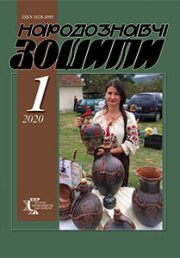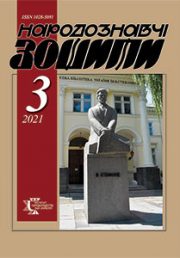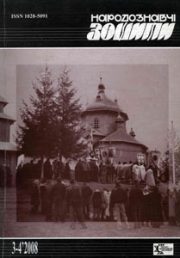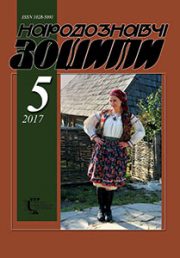The Ethnology Notebooks. 2023. № 1 (169), 227—239
UDK [398.8(=161.2):398.33]:801.81
DOI https://doi.org/10.15407/nz2023.01.227
ORIGIN OF KOLIADA: PHENOLOGICAL CONCEPT
DAVYDIUK Viktor
- ORCID ID: https://orcid.org/0000-0001-9019-0446
- Doctor of Philology, Professor,
- Lesya Ukrainka Volyn National University,
- of the Departament of Ukrainian Literature,
- 13, Prospect Voli, Lutsk, 43025, Ukraine,
- Contacts: e-mail: totem2004@bigmir.net
Abstract. The relevance of the study is defined by the need to consider the origin of Koliada tradition regarding its spread and the correspondence of the phenology of folklore texts to those calendar milestones, which have been followed since at least the 19th century.
The purpose of the article is to analyze the conformity of established opinions about the Greco-Roman vector of Koliada spread to Ukrainian lands with the real facts of its existence in the phenological context, reflected in the texts of carols and rare facts of non-traditional use of carols in «inappropriate» calendar terms.
The object of the research is the established opinions of well-known scientists regarding the origin and spread of Koliada traditions in Ukraine in the light of new or little-known but revealing facts. Having applied a phenological approach to Uk rainian carols, the author assumes the autochthonous origin not only of their texts but also of their genre. Greco-Roman influences, which many authors saw in Ukrainian caroling traditions, only concern religious samples, that is, psalms. As for Ukrainian secular carols, they mainly reflect agrarian economic processes, which are not characteristic of either the Greeks or the Romans. The very name of the genre is of Slavic origin, and the Roman calendar is rather derived from it since it does not have a clear etymology in any of the Romance languages, and besides, the name of the holiday, along with kalenda or kolinda, has other authentic names with transparent etymology. Mostly, the word «carol» is used only where the word «circle» is known. In addition to the Slavic countries, only Romania and Hungary can be considered the result of borrowing. It is not characteristic of Muscovites either, who have a completely different meaning of the winter calendar rites. Ukrainian carols have the widest phenological range of their application. They present such labor processes as plowing, sowing, weeding, trubbing, harvesting, and the completion of threshing, i. e. they cover the whole annual cycle. Separately presented is «kolodka», which means chopping firewood at the end of winter, the name of which also has the root «kolo». The center of the caroling traditions spread also falls on the territory of Ukraine.
The author concludes with the Slavic origin of caroling as a system of circuitous rites throughout the year, during which unmarried youth were involved in the performance of public works.
Therefore, Ukraine may be considered, if not the homeland of caroling, then part of the area of formation of this tradition.
Keywords: Koliada, annual agrarian cycle, phenological calendar, carols, shchedrivky (Christmas songs), devotional rites.
Received 25.01.2023
REFERENCES
- Dolenga-Khodakovsky, Zorian. (2007). About Slavs before Christianity Folkloristic notebooks (Issue 10, p. 199) [in Ukrainian].
- Kolessa, F. (1938). Ukrainian oral literature. Lviv [in Ukrainian].
- Potebnya, A. (1887). Explanation of Little Ruthenian and related songs. Christmas carols and gifts (Vol. 2, p. 166). Warsawa [in Russian].
- (1137). The story of past summers. (1989). Kyiv [in Ukrainian].
- Pchilka, Olena. (1903). Ukrainian carols (Volyn text). Kyivskaya starina, 1, 162 [in Russian].
- Petrov, V. (2013). Ukrainian folklore (conspiracies, wails, ritual folklore of the folk-calendar cycle). Bereginya, 3—4 [in Ukrainian].
- Kylymnyk, S. (1964). Ukrainian year in folk customs in historical light (Vol. 1, p. 13). Winnipeg; Toronto [in Ukrainian].
- Sosenko, K. (1994). Cultural and historical figure of the old Ukrainian holidays of Christmas and Shchedro vechar. Reprint edition (Pp. 41—47, 94—97). Kyiv [in Ukrainian].
- Hnatyuk, V. (1916). Foreword to: Christmas carols and generous gifts. Ethnographic Herald (Vol. 35, pp. III—XIV; Vol. 36, pp. III—XV) [in Ukrainian].
- Kurochkin, O. (1978). New Year holidays of Ukrainians: traditions and modernity (P. 89). Kyiv [in Ukrainian].
- Rylskyi, M.T. (Ed.). (1958). Ukrainian folk poetic creativity (Vol. 1, p. 249). Kyiv [in Ukrainian].
- Davydyuk, V. (2003). Historical-geographic attribution of gifts and Christmas carols. Folklore notebooks (Issue 6) [in Ukrainian].
- Veselovsky, A.N. (1883). Explorations in Russian spiritual verse. Romanian, Slavic and Greek carols (Issue VII). St. Petersburg [in Russian].
- (1991). Creation of the populare (Course theory of the folklore of the Roma people of Bessarabia, Transnistrian Bukovyna). Chisinau [in Moldovan].
- Svientsitskyi, I. (1933). Christmas in the course of ages. Lviv [in Ukrainian].
- Antohi, L. (2012). Figurative and subject series of Moldavian «carols» Literature. Folklore. Problems of poetics. Collection of scientific works (Issue 36) [in Ukrainian].
- Hrushevskyi, M. (1993). History of Ukrainian literature (Vol. 1). Kyiv [in Ukrainian].
- Kvitka, K. (1971). Selected works (Vol. 1). Moscow [in Russian].
- Pastukh, Nadiya, & Kharchyshyn, Olga (Eds.). (2020). Folklore of Ukrainians of northern Moldova. Recorded and edited by Olga. Lviv [in Ukrainian].
- Korobka, N. (1902). Kolyadki and shchedrovky recorded in Volynsko Polesia. St. Petersburg [in Russian].
- (2019). Poliska doma (Issue 4: winter). Lutsk [in Ukrainian].
- Veselovsky, A.N. (1883). Searches in the area of Russian spiritual verse. Romanian, Slavic and Greek carols (Vol. VII). St. Petersburg [in Russian].
- Bessonov, P. (1871). Belarusian songs. Moscow [in Russian].
- Propp, V. (2000). Russian agricultural holidays. Moscow [in Russian].
- Krasnovskaya, N. (1977). Italians. Calendar customs and ceremonies in foreign countries. The end of the 19th century — the beginning of the 20th century. Spring holidays. Moscow [in Russian].
- Salmanovych, M. (1977). Romanians. Calendar customs and ceremonies in countries abroad in Europe. Winter holidays. Moscow [in Russian].
- Kashuba, M. (1977). People of Yugoslavia. Calendar customs and rituals in foreign countries Winter holidays (P. 241). Moscow [in Russian].
- Koleva, T. (1977). Bolgary. Calendar customs and ceremonies in foreign countries. Winter holidays (P. 270). Moscow [in Russian].
- Lesya Ukrainka’s letter dated December 21, 1891. January 2, 1892) from Kolodyazhny to M.P. Drahomanov. Lesya Ukrainka. Letters: 1876—1897 (P. 167) [in Ukrainian].
- Tokarev, S. (1977). Western Slavs. Calendar customs and rituals in foreign countries of Europe. Winter holidays. Moscow [in Russian].
- Potebnia, A. (1865). On the mythical meaning of some rites». Moscow [in Russian].
- Chicherov, V. (1957). The winter period of the Russian agricultural calendar. XV—XIX centuries. (Essays on the history of national history). Moscow [in Russian].
- Sokil, H. (2004). Ukrainian round-the-clock calendar-ritual songs. Structure, functions, semantics. Lviv [in Ukrainian].
- Davidyuk, V. (2000). Relics of the drag tradition in Ukrainian ceremonial folklore. Bulletin of Lviv University. Ukrainian folklore (Pp. 60—67) [in Ukrainian].
- Krymskyi, A. (2012). Harvest. The Ethnology notebooks, 2 [in Ukrainian].







